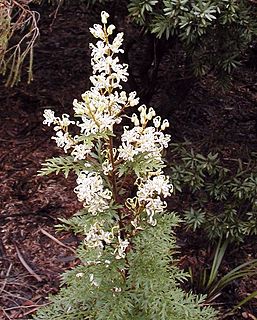
Matteuccia is a genus of ferns with one species: Matteuccia struthiopteris. The species epithet struthiopteris comes from Ancient Greek words στρουθίων (strouthíōn) "ostrich" and πτερίς (pterís) "fern".

Platycerium is a genus of about 18 fern species in the polypod family, Polypodiaceae. Ferns in this genus are widely known as staghorn or elkhorn ferns due to their uniquely shaped fronds. This genus is epiphytic and is native to tropical and temperate areas of South America, Africa, Southeast Asia, Australia, and New Guinea.

Dicksonia antarctica, the soft tree fern or man fern, is a species of evergreen tree fern native to eastern Australia, ranging from south-east Queensland, coastal New South Wales and Victoria to Tasmania.

Sphaeropteris cooperi, synonym Cyathea cooperi, also known as lacy tree fern, scaly tree fern, or Cooper's tree fern, is a tree fern native to Australia, in New South Wales and Queensland.

Asplenium nidus is an epiphytic species of fern in the family Aspleniaceae, native to tropical southeastern Asia, eastern Australia, Hawaii, Polynesia, Christmas Island, India, and eastern Africa. It is known by the common names bird's-nest fern or simply nest fern.

Onoclea sensibilis, the sensitive fern, also known as the bead fern, is a coarse-textured, medium to large-sized deciduous perennial fern. The name comes from its sensitivity to frost, the fronds dying quickly when first touched by it. It is sometimes treated as the only species in Onoclea, but some authors do not consider the genus monotypic.

Sphaeropteris excelsa, synonym Cyathea brownii, commonly known as the Norfolk tree fern or smooth tree fern, is probably the largest fern species in the world. It is endemic to Norfolk Island, in the Pacific Ocean near Australia and New Zealand. It is named after the botanist Robert Brown (1773-1858).

Alsophila australis, synonym Cyathea australis, also known as the rough tree fern, is a species of tree fern native to southeastern Queensland, New South Wales and southern Victoria in Australia, as well as Tasmania and Norfolk Island.

Cyrtomium falcatum is a species of fern, commonly known as house holly-fern and Japanese holly fern, in the wood fern family Dryopteridaceae. It is native to eastern Asia.

Asplenium australasicum, the bird's nest fern or crow's nest fern, is an epiphytic Australasian species of fern in the family Aspleniaceae.

Platycerium bifurcatum, the elkhorn fern or common staghorn fern, is a species of fern native to Java, New Guinea and eastern Australia, in New South Wales, Queensland and on Lord Howe Island. It is a bracket epiphyte occurring in and near rainforests. Growing to 90 cm (35 in) tall by 80 cm (31 in) broad, it has heart-shaped sterile fronds 12–45 cm (5–18 in) long, and arching grey-green fertile fronds which are forked and strap-shaped, and grow up to 90 cm (35 in) long.

Todea barbara is known as the king fern. Occurring in moist areas of south eastern Australia, and also indigenous to New Zealand and South Africa.

Lomaria nuda, commonly known as the fishbone waterfern, is a fern that grows up to a metre tall, and is abundant in rainforest and eucalyptus forests in eastern Australia. The species is placed in the genus Lomaria in the Pteridophyte Phylogeny Group classification of 2016, but is often retained in genus Blechnum as Blechnum nudum.

Doodia aspera, commonly known as prickly rasp fern, is a widespread and common plant, growing in eastern Australia. Often seen in rainforest margins or eucalyptus forest in Victoria, New South Wales and Queensland, it is a terrestrial fern with reddish new growth.

Aglaomorpha is a genus of ferns in the subfamily Drynarioideae of the family Polypodiaceae. The Pteridophyte Phylogeny Group classification of 2016 uses this genus name, while other sources use Drynaria to include Aglaomorpha. Species are commonly known as basket ferns. As circumscribed in PPG I, the genus contains around 50 species.

Osmunda spectabilis, known as American royal fern, is a species of fern native to a large area of the New World, from Canada to Argentina.

Lomatia silaifolia, commonly known as crinkle bush or parsley fern, is a plant of the family, Proteaceae native to eastern Australia. Naturally found in open forest, it grows as a small shrub 1–2 m high with highly pinnate leaves reminiscent of parsley. The white inflorescences appear in summer.

Lygodium japonicum is a species of fern that is known by the common names vine-like fern and Japanese climbing fern. It is native to eastern Asia, including Taiwan, Japan, Korea, southeastern Asia, and India, and eastern Australia. The fern is present in the southeastern United States and Puerto Rico as an introduced species.

Alsophila borbonica, synonym Cyathea borbonica, is a tree fern endemic to Mauritius and Réunion. There are several natural forms and varieties.

Platycerium grande, the giant staghorn fern, capa de leon, and dapong repolyo, is a species of epiphytic fern in the family Polypodiaceae. It is one of the two staghorn ferns native to the Philippines, along with P. coronarium, and is endemic to the island of Mindanao, in the provinces of Zamboanga, Lanao and Davao. P. grande is often collected from the forests and sold as a highly prized ornamental plant. Due to overcollection and the difficulty of the spores to germinate under natural conditions, in vitro technique is necessary to ensure mass production of this plant species. The local government categorized it as critically endangered species.




















